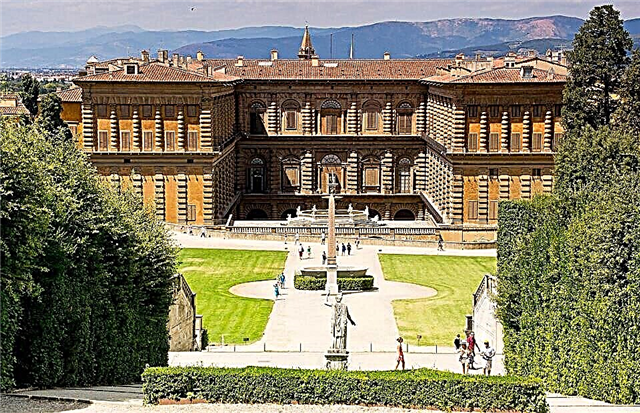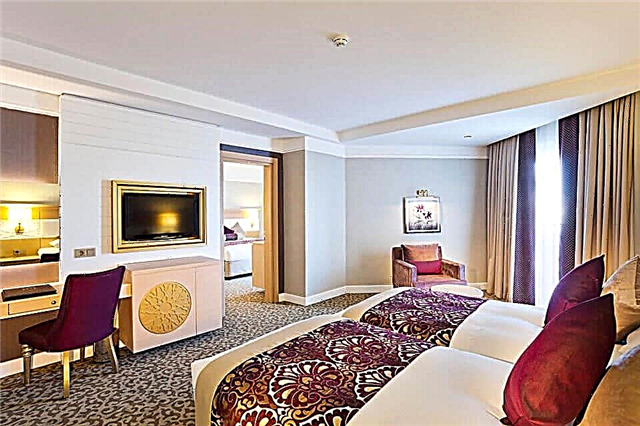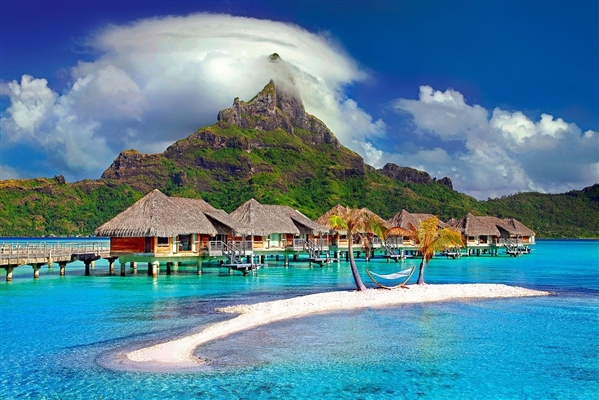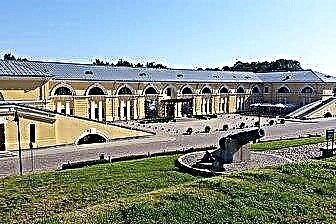An ancient city, the capital of Kievan Rus, the cradle of Slavic culture - Kiev will welcome tourists with millennial churches and monasteries, graceful European squares and, no doubt, a seething stream of historical events. This is the place where statehood was forged, and the pillars of the Russian Orthodox faith were established, where History continues its bizarre chronicle even now.
Kiev is constantly becoming a venue for various music and sports events of the European level. Many national festivals take place here, especially in the summer. It will be interesting for a tourist to visit the Embroidery Day, dedicated to the traditional costume, or to walk along Khreshchatyk on the City Day, merging with the easy crowd of cheerful Kievites.

The best hotels and hotels at affordable prices.
from 500 rubles / day
What to see and where to go in Kiev?
The most interesting and beautiful places for walking. Photos and a short description.
Kiev-Pechersk Lavra
One of the first monasteries of Kievan Rus, a revered and important Orthodox shrine. The monastery is included in the UNESCO heritage list. The Lavra was founded in the 11th century by the monk Anthony and his disciple Theodosius. The architectural complex of the Kiev-Pechora Lavra includes several churches, a theological seminary, cave monasteries, the State Library of Ukraine and a museum complex. The relics of God's saints are kept in the Lavra.

St. Michael's Golden-Domed Monastery
An Orthodox monastery, founded in the 11th century on the site of a former pagan temple, where ceremonies were performed in honor of Perun, Svarog, Khors and other deities of the ancient Slavic pantheon. The first church on the site of the future monastery was made of wood. At the beginning of the 12th century, in honor of the victory over the Polovtsy, the foundation stone of the Cathedral of the Archangel Michael began, at which the monastery was established. On the square in front of the temple there is a sculptural group consisting of monuments to Princess Olga, Cyril and Methodius, the Apostle Andrew.

St. Vladimir's Cathedral
Orthodox church of the late 19th century, made in a picturesque and magnificent Old Byzantine style. The cathedral is distinguished by magnificent interior and exterior decoration. The facade is decorated with arched windows and openwork stucco molding, the main entrance doors depict Prince Vladimir and Princess Olga, the inner vaults are painted with bright thematic frescoes, which were worked on by M. Vrubel, V. Vasnetsov, M. Nestorov and other famous painters.

Sophia Cathedral
Temple-museum, built by the will of Yaroslav the Wise in the XI century. The cathedral was repeatedly attacked and destroyed: in the XIII century it was plundered by the hordes of Batu, in the XIV it was besieged by the Uniates, and centuries later - by the Crimean Tatars. The temple survived and in the 17th century, work began on its restoration. In the 90s. the building was included in the UNESCO heritage list, so religious services on its territory almost ceased. The exception is religious holidays.

Nicholas Church
Catholic cathedral, where in the 80s. XX century, the House of Organ and Chamber Music was organized. In 2001, the temple was honored with a visit by Pope John Paul II himself. The church was built in the classical Gothic style at the beginning of the 20th century. Until that time, there was only one Catholic church in Kiev, which could not accommodate everyone. Nicholas Church was built for ten years exclusively on private capital.

St. Andrew's Church
Temple of the mid-18th century in the Baroque style, located on a hill in the historical part of Kiev. It is considered one of the most beautiful churches in Kiev. According to the ancient legend, to which the "Tale of Bygone Years" refers, at this place the Apostle Andrew the First-Called put up a cross and proclaimed that there would be a great city here. Kiev was founded several centuries later.

Andrew's Descent
Street in the center of Kiev, which appeared in the historical period of Kievan Rus. In ancient times, it connected the Upper and Lower cities. The official date of the appearance of Andreevsky Spusk is 1711, when, by order of the Governor, the passage between Andreevskaya and Zamkovaya Gora was expanded. The passage became suitable not only for passengers, but also for carriages, horsemen and carts drawn by oxen.

Richard's Castle - Lionheart
The building is in the English neo-Gothic style of the early 19th century. Locals poetically name it after the legendary King Richard the Lionheart. The creator of the structure is unknown. Presumably, the castle was built for lease, later it was acquired by the Orlov family. There were always ominous rumors about the castle. Allegedly, he often changed owners due to the fact that evil spirits lived inside. But later the legend was debunked, as the necks of bottles were found in the walls, producing an ominous howl.

House with Chimeras
An unusual mansion built at the beginning of the 20th century in the Art Nouveau style. Its architecture is quite unusual for the Ukrainian capital. The facade and interior are decorated with statues and images of animals, fabulous creatures, inhabitants of the underwater world. The mansion was built according to the project of V. Gorodetsky. This master took part in the construction of the Church of St. Nicholas and the Ukrainian National Art Museum.

The building of the National Bank of Ukraine
An elegant mansion in the "Venetian" style, located in the Pechora Lipki area. The building was erected at the beginning of the 20th century according to the design of engineers M. Verbitsky and A. Kobelev. The cladding of the facade was done by the Italian sculptor E. Salja. During construction, many innovative solutions for the time were tested, including electric lighting and a steam central heating system.

Kiev National University
Red building KNU them. Taras Shevchenko is the oldest building of this educational institution. In addition to its practical functions, the building is a valuable architectural monument and a popular excursion destination. The red building was erected in the 19th century in the style of Russian classicism, which was relevant at that time. It houses the administration, a number of university departments and history museums.

Khreshchatyk street
The main metropolitan street, presumably located not far from the place where Prince Vladimir was baptized. The street is only 1.3 km long. from European to Bessarabskaya square. Active development of Khreshchatyk was carried out in the XVIII-XIX centuries. The modern name has been fixed since 1869. Khreshchatyk becomes a pedestrian street during public holidays or significant public events.

Landscape alley
Alley, created in the 80s. XX century as part of a large-scale project for the construction of the historical architectural reserve "Ancient Kiev". The plans remained on paper, and the Landscape Alley remained the only completed object. The observation deck near the Historical Museum offers a panoramic view of the Dnieper and Podil. Since 2009, a children's park has been organized within the alley.

Maidan
The central square of the Ukrainian capital. The place where the modern history of the state took place. In the second half of the 19th century, merchants settled on the site of the future square. There was a large market, where festivities were held on holidays. The central attraction of the Maidan Nezalezhnosti is an imposing monument erected in honor of the separation of Ukraine from the Soviet Union and the formation of an independent state.

Sofia square
One of the oldest city squares in Kiev. It is believed that it was in this place that Yaroslav the Wise defeated the Pechenegs in the 11th century. A monument to the great hetman Bogdan Khmelnitsky, a fighter against the Polish and Turkish invaders, is erected on the square.The commander is depicted on horseback in a courageous heroic pose. Another architectural landmark is the stone bell tower of St. Sophia Cathedral, built at the beginning of the 18th century. In 1709, a meeting of the victors of the Battle of Poltava took place here.

Kontraktova ploshcha
The square has been known since ancient times as a venue for contract fairs (hence the name). Until the middle of the 19th century, it was considered the center of Kiev. Several popular sights of Kiev are located here: the Gostiny Dvor of the early 19th century, the contract house, the Church of the Mother of God Pirogoscha, the Kiev-Mohyla Academy, the Samson fountain and other buildings.

Taras Shevchenko Opera House
National Opera House of Ukraine, the largest and most famous in the country. It is a real architectural decoration of Kiev. At the end of the 19th century, such works as Eugene Onegin, The Queen of Spades by I. Tchaikovsky, Aleko by S. Rachmaninov, and The Snow Maiden by N. Rimsky-Korsakov were staged on the stage of the opera house (the maestro was personally present at the performances). The great Russian reformer P.A.Stolypin was killed in the theater.

National Museum of the History of Ukraine
The exposition began with a small archaeological exhibition organized at the City Museum of Antiquity and Art. The official opening took place in 1904. The museum halls display archaeological collections, weapons, coins, unique books, porcelain and other historical artifacts. The total number of exhibits is more than 800 thousand copies. In addition to the permanent exhibition, the museum organizes temporary exhibitions.

Bulgakov Museum
The house-museum is located on Andreevsky Spusk in the historical center of Kiev. The writer's family lived there until 1919. The building was named "House of the Turbins" thanks to an article in a 1967 literary magazine. That is, the house became a haven for both the Bulgakov family and the heroes of one of his works, the Turbins. The exposition was opened in 1991, the collection was based on a private collection of the first director of the museum A. Konchakovsky.

Water Museum (Water Information Center)
The exposition is located in the 19th century water towers, which were renovated and restored in 2003. The buildings themselves are of considerable historical value and are of interest to tourists. During the excursion, visitors will be able to learn about the structure of the Earth's hydrosphere, about various processes that are impossible without the participation of water, and about the harmful human activities that result in pollution and depletion of water resources.

Pirogovo open air museum
In the museum you can learn a lot about the life and national traditions of Ukraine. On an area of more than 150 hectares, there are 300 exhibits that tell about different aspects of the life and culture of Ukrainians. Here you can stroll along the streets of the village, look at traditional Ukrainian huts, look into an old wooden church, or have a family picnic on a green lawn against the backdrop of picturesque hills.

Mariinsky Palace
An architectural monument of the middle of the 18th century, built in the brilliant era of Empress Elizabeth. The famous architect B. Rastrelli worked on the palace. The building was used as a royal residence and a temporary refuge for important persons of the Russian imperial court. After a fire in the 19th century, the palace was destroyed. The restored building was surrounded by a magnificent landscape park, where Maria Alexandrovna, the wife of Alexander III, loved to rest.

Kiev fortress
A complex of fortifications on the right bank of the Dnieper River. It includes several earthen fortifications, citadels, household and administrative buildings. The history of the fortress dates back to the 5th century. Then on the Starokievskaya mountain there was a fortified ancient settlement. After the destructive campaign of Batu Khan against Russia in the 13th century, the structures fell into decay. The Kiev fortress regained its military significance during the Russian-Swedish war of 1700-1721.

Golden Gate
An architectural monument of the XI century, the remains of the fortifications of ancient Kiev. For the first time the gate is mentioned in the "Tale of Bygone Years". They performed not so much a defensive function as they were the main entrance to the city. During the construction, fired brick and a mortar of slaked lime were used, which ensured the strength and good preservation of the structure.

Motherland
Monumental female statue with a shield and a sword, glorifying the victory in the Great Patriotic War. The monument is part of the memorial complex dedicated to the history of the Second World War (the official name is the Museum of the History of Ukraine in World War II). This is one of the largest expositions in Ukraine. The height of the monument is 102 meters. When it was created, it was assumed that the statue would last 150 years and be able to withstand a strong earthquake.

Babi Yar
A ravine between the urban districts of Syrets and Lukyanovka, where the German invaders in 1941 massively shot the population. In a fairly short period of time, tens of thousands of Kievites were killed and buried in mass graves here, the total number of victims exceeded 100 thousand people. Nowadays, within the territory of Babi Yar, there are memorials dedicated to the numerous victims of executions.

Park Vladimirskaya Gorka
City park on Mikhailovskaya Gora. There is a monument to Prince Vladimir - the Baptist of Russia. Thanks to the monument, the place was named "Vladimirskaya Gorka". Three levels of the park are spread along the slope of the mountain: lower, upper and middle terraces. An excellent panorama of the city quarters opens up from here. Vladimirskaya Gorka is one of the favorite places for walks in Kiev.

Botanical Garden named after N.N. Grishko
Botanical Garden of the National Academy of Sciences of Ukraine. On its territory is the Holy Trinity Ioninsky Monastery. The garden covers an area of 130 hectares and has a large arboretum where magnolias, irises, jasmine, lilacs, crocuses, daffodils, roses and dozens of other plants grow. In the greenhouse, you can admire exotic views brought here from different parts of the world.

Kiev funicular
A unique funicular from the beginning of the 20th century, serving as a public transport, one of the first in the Russian Empire. On it you can climb from Podol to the Upper Town. Earlier on the site of the funicular there was a staircase of 500 steps. Climbing it could be equated with real physical training. The system can transport up to 4,000 thousand people per hour, the travel time is no more than 2-3 minutes.

Hydropark
An entertainment complex with a system of beaches, attractions, boat stations. The park was created in the 60s. XX century. The eponymous station of the Kiev metro is located on the territory. The modern Hydropark is a set of entertainment establishments, bars and discos, which are ready to receive several thousand people every day, as well as a gym, places for team games and the park "Kiev in miniature".












